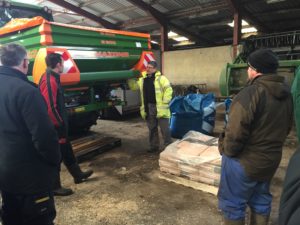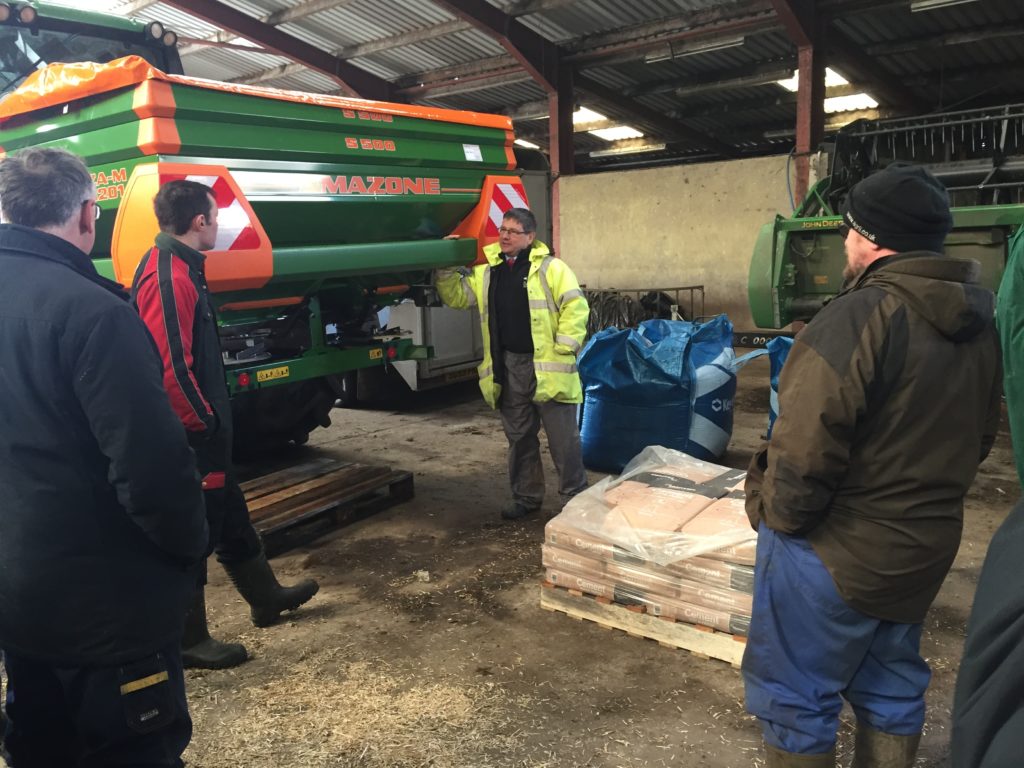West Lothian Nutrient Network Farm Final Meeting – Event Summary
8 March 2018The third and final meeting of the West Lothian Soil & Nutrient Network was held at West Binny Farm. The topics for discussion were GPS soil analysis, fertiliser, an update on the nutrient budget, the importance of tyre selection and pressures, and calibrating fertiliser spreaders.
Craig Bothwell started the meeting off with an update on the soil & nutrient network farm project and gave a brief recap on the farm, its stocking and cropping. Jonathan Black demonstrated that the savings in lime from two fields covered the sampling costs and that Lime was targeted exactly to where it was required.
Gavin Elrick gave a presentation on different sources of fertiliser and what would be the cheapest forms of N P & K and the group engaged in discussion with this and how it could best fit in with their cropping. We also looked at different grades of fertiliser and how these affect the spreading pattern as well as flow rate for calibrating the fertiliser spreader.
Chris McDonald showed the group the silage mineral analysis and asked everyone to guess the quantities of fertiliser that would be required to cover crop offtake at West Binny. This led into discussion of nutrients etc.
Craig finished off the meeting talking about soil compaction and how with correct tyre selection and management you can reduce soil compaction.
Please use the links below to download the information leaflets that were available on the day. Read the event summaries for the first and second meetings of the West Lothian SNN group.
West Binny Farm is one of 12 host farms across Scotland as part of the Soil & Nutrient Network. These farms are taking a ‘before and after’ look at how to protect and improve farm soils and make best use of both organic and inorganic fertilisers, saving money, benefitting yields and improving farm efficiency and resilience.
You can read more about some of the other and historic host farms on the Farming & Water Scotland webpage.
- Valuing Your Soils – Practical Guidance for Scottish Farmers
- This brochure includes useful information about Scotland's agricultural soils and practical advice outlining the upfront financial savings and business benefits of better soil management and the efficient use of resources. Action and problem-specific 'field-sheets' are designed for busy farmers with limited time for reading.
- Topics: Climate Change, Soils, Water Management and Crops and Soils
- Visual Evaluation of Soil Structure (VESS) Score Chart
- This is a downloadable copy of the Visual Evaluation of Soil Structure (VESS) score chart for use in-field.
- Topics: Soils
- Technical Note (TN656): Soil Information, Texture & Liming Recommendations
- • Web based access to information on your soils on your farm is described. • Soil texture classes of mineral soils are described and identified by hand texturing. • Liming recommendations for different soils and managements are tabulated.
- Topics: Soils
- Technical Note (TN668): Managing Soil Phosphorus
- Efficient soil P management is challenging due to the varying ability of soils to mediate and regulate plant available forms of P. Farmers and land managers in Scotland are now able to access farm level information about their soils making it possible to provide more accurate P management advice.
- Topics: Crops and Soils
- Practical Guide: Tyre Selection & Management
- This practical guide explains how to reduce soil damage, improve fuel usage and reduce overall green house gas emissions by selecting the correct tyre size, type and pressure.
- Topics: Climate Change
- Practical Guide: Soil sampling I – How to take a soil sample
- This practical guide details what is required to take a soil sample for analysis that is representative of the area sampled.
- Topics: Climate Change, Soils and Water Management
- Practical Guide: Soil sampling II – Benefits to your business
- This practical guide details how soil sampling can benefit businesses by increasing productivity and create efficiencies on fertiliser inputs through better nutrient planning.
- Topics: Climate Change, Soils and Water Management
- Practical Guide: Nutrient budgeting I – The Benefits to your Business
- This practical guide looks at the benefits of creating and using a nutrient budget for your farm business.
- Topics: Climate Change
- Practical Guide: Nutrient Budgeting II – Getting Started
- This practical guide looks at what factors you need to consider when making a nutrient budget for your farm, fertiliser recommendations and how to get the most out of your nutrient budget.
- Topics: Climate Change
Sign up to the FAS newsletter
Receive updates on news, events and publications from Scotland’s Farm Advisory Service

